Content
The 2CV

Good old "tortoise"
It is a symbol of France like the beret, baguette and Brigitte Bardot: the 2CV, nick-named "tortoise" in Britain or “duck” (“Ente”) in Germany. The Citroen 2CV was first introduced in Paris 75 years ago. A tribute to an automobile that has grown closer to the hearts of more people than any other over generations (except perhaps for the VW Beetle).
The tortoise egg was laid as early as the mid-1930s: Citroën started the TPV project - for "Toute Petite Voiture", a very small car so it should be, a minimalist, inexpensive vehicle for everyone, but especially for the rural population. "Design a car that has room for two farmers in boots and a quart of potatoes or a barrel of wine, is at least 60 km/h fast and consumes only three liters per 100 km," is what the chief engineer André Lefèbvre was expected to do.
Lefèbvre is also said to have been given the specification that the TPV should be able to cope with even the worst road surfaces and had to be very easy to operate. Great importance was also attached to a particularly good suspension: a basket full of eggs was to survive a ride on bumpy country roads to the market undamaged.
The "ugly duckling" hatches
250 prototypes of the TPV were built. But the World War prevented the introduction of the French “people´s wagon”. Citroen hid his project car from the German occupiers, who had tanks made in the factories of the company.
On 7 October 1948 Citroën finally let the duck hatch out of the egg at the Paris Motor Show. The new small car was in comparison to the TPV a completely revised model with an air-cooled engine and substantially prettier than the unsightly prototype, but was mocked nevertheless first as "ugly duckling" or "sardine can".
2CV stands for "deux chevaux", "two horses". This did not refer to the horsepower number, as some people thought (the first duck had nine "chevaux vapeur", i.e. 9 hp!), but to the number "cheval fiscal" in the French vehicle tax system at that time, where criteria such as number of gears, gear ratio and tyre size also played a role. This designation was also common for other French models of the time (such as the Renault 4CV).
Bestseller with 9 PS
The 2CV was a cheap car. The simple technology kept the maintenance costs low, the small cubic capacity the tax. Therefore the concept worked out and the car sold well - so well that at the beginning up to 6 years delivery time resulted. Not even that deterred the buyers. The 2CV became Citroen's most successful car. Between summer 1949 and mid 1990s, 3,868,631 four-door limousines and 1,246,335 vans were built.
Two men, three classics
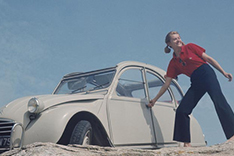
Citroen ad, 1964
The two fathers of the "duckling", designer Flaminio Bertoni (1903-1964) and constructor André Lefèbvre (1894-1964), are also responsible for two other classics of automobile history that could hardly be more different:
In 1934, the Traction Avant ("front-wheel drive") was presented, which became known under the nickname "gangster car" - its excellent driving characteristics made it the most popular getaway vehicle of its time.
Equally technical, but above all visually avant-garde was the "goddess" of 1955: the Citroen DS, "la déesse". A true icon, full of technical innovations (including hydro-pneumatics, power steering), packaged in a design that is still much admired today. Next to the ultra-modern "goddess", the 2CV really only just looked like an ugly old duckling... but that is precisely why many hearts flew to it.
Anachronistic charm
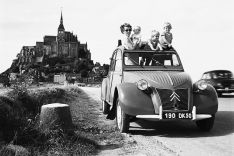
On a grand tour, 1959
In the late 1960s, when the duckling had long since become technically obsolete and developed an anachronistic charm, it became "cult": students, individualists, hippies and consumer critics discovered it for themselves. Here in Germany, the 2CV was regarded as a leisurely, well sprung ambassador for a relaxed French way of life, standing for "laisser-faire" and "savoir-vivre". But the duckling was also "the right car for people who actually didn't want a car or couldn't afford one", as the "Frankfurter Allgemeine Zeitung" once wrote.
The 2CV became an element of pop culture: there were “tiger ducks”, ducks as mock police vehicles and rally ducks. Even luxury-spoiled James Bond sat at the wheel of a duckling and rode it through olive groves (in the film "For your eyes only").
Upgrading the duckling

Agent duckling: James Bond Special edition of 2CV
The 2CV with its popular folding roof and the characteristic revolver gear changing was carefully improved during its long manufacturing period: in 1957 the duckling was fitted with a heater and even a trunk lid. Now it was no longer necessary to open the soft top on the underside to get to the boot.
In 1964 the speedometer was moved from the window column to the dashboard; a fuel gauge replaced the measuring rod. The front bench seat was only replaced by two single seats in 1971. But already in 1972 there were 3-point safety belts as standard (this was not a matter of course at that time!).
In the course of the years the engine power of the duckling tripled. The last types of the air-cooled two-cylinder boxer engines with 29 HP power they accelerated to 115 kilometers per hour. But then the coachwork was already rattling quite nicely.
By the way, you could start the engine with all 2CV with the help of the jack crank if necessary. From the beginning the 2CV had a manual headlight range control.
Rocking and cuddly
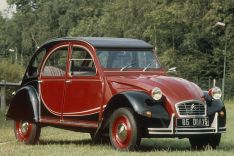
Edition "Charleston", 1982
The characteristic 2CV driving feeling always remained the same: the soft suspension gave it good off-road mobility, but in the bend the strong lateral inclination took getting used to. Thanks to the light body and a low centre of gravity, however, it was very unlikely that the car would tip over.
There were different special models like the "Sahara duckling" with all-wheel drive and two engines. Most popular in Germany was the nostalgic "Charleston" model, which made the duckling look even older than it already was and in the 1980s provided for a new sales boom (By the way, Citroen only secured the "Charleston" brand as a brand long after the end of the duck, see Charleston brand registration number: 39843270).
After four decades on the road
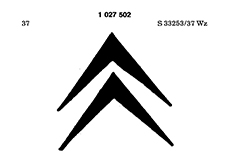
1027502DE
When the end of the duckling approached, it had been technically obsolete for decades (by the way, the current state of the art in automotive engineering can easily be seen from the latest patent applications in the DPMA database DEPATISnet). Production in France was discontinued in 1988. On 27 July 1990, the last 2CV rolled off the assembly line at the Citroën plant in Mangualde, Portugal.
Today, the surviving 2CV are enjoying an active lovers' scene. Well-kept examples have long since had their price. The "Sahara duckling" plays in a league of its own with all-wheel drive and two engines that are traded for six-digit amounts.
In 2002, the 2CV was voted "car of the 20th century" in France. The duckling (which by the way is not called "canard" there, but "deuche" or "deux-pattes" - "double paw") belongs to the cultural heritage of the country like Eiffel Tower, Brie and Bordeaux.
Citroen company logo (1027502DE, registered in this form in 1979): Company founder André Citroën (1878-1935) was inspired by the helical or arrow-shaped teeth of gear wheels, which were among the first products produced by his company.
Bilder: Citroen Kommunikation, DPMAregister
Last updated: 10 December 2025

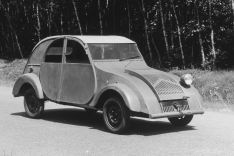
Not only protecting innovations
Social Media